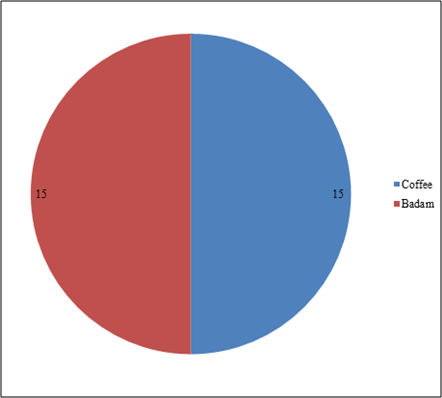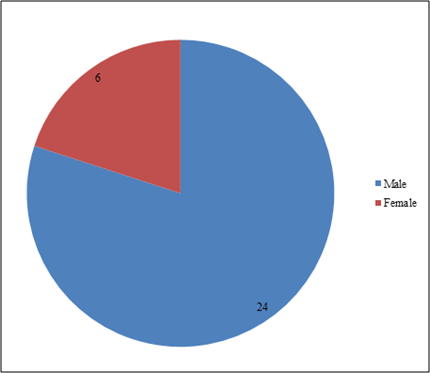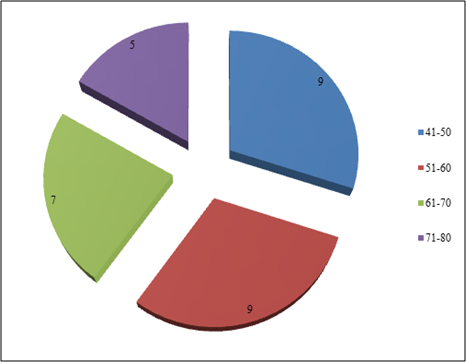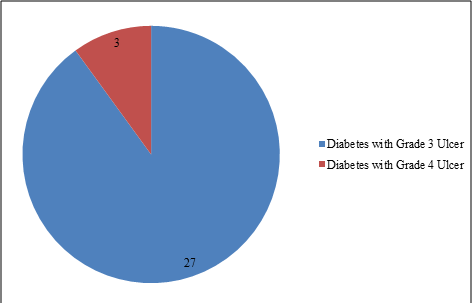Efficacy of Oral Protein Supplementation “PRO 360 Diabetic” on Diabetic Foot Ulcer Patients-A Pilot study
Article Information
Rajesh Kesavan1, Changam Sheela Sasikumar2*, Yuwanesh Thirunawkkarasu3
1Podiatric Surgeon, Hycare Super Speciality Hospital, Arumbakkam, Chennai, India
2Head-Clinical Research, Hycare Super Speciality Hospital, Arumbakkam, Chennai, India
3Clinical Research Coordinator, Hycare Super Speciality Hospital, Arumbakkam, Chennai, India
*Corresponding Author: Changam Sheela Sasikumar, Head-Clinical Research, Hycare Super Speciality Hospital, Arumbakkam, Chennai, India
Received: 18 July 2020; Accepted: 06 August 2020; Published: 14 August 2020
Citation: Rajesh Kesavan, Changam Sheela Sasikumar, Yuwanesh Thirunawkkarasu. Efficacy of Oral Protein Supplementation “PRO 360 Diabetic” on Diabetic Foot Ulcer Patients-A Pilot study. Journal of Food Science and Nutrition Research 3 (2020): 195-205.
View / Download Pdf Share at FacebookAbstract
Foot ulcers are the main source of morbidity and a leading cause of hospitalization for persons suffering from diabetes. There is a steady increase in type 2 diabetes globally, especially among young and obese people. The main objective of the study is to assess the efficacy of oral supplementation “Pro360 Diabetic” a nutrition supplement in diabetic foot ulcers a complication predominant in diabetes. The subjects were randomly divided into two groups. Group 1 received Pro 360 coffee flavor Protein supplement and Group 2 received Pro360 Badam flavour Protein supplement daily for a period of 3 months. The following parameters CBC, HbA1c, Lipid profile, Urea, Creatinine and Total Protein were analyzed at baseline and every visit. The data obtained along with the patients’ age and gender was subjected to statistical analysis by SPSS to evaluate the efficacy of supplement in foot ulcer patients. The results showed that there is statistical variation in the clinical variables of both the groups and badam flavor is found to be better than coffee flavor. It can be inferred that p value <0.05 is statistically significant for total protein on 0th day and 90th day related to age. In conclusion Pro 360 diabetic with micronutrients can be implemented as oral protein supplement in diabetic foot ulcer patients but further studies need to be conducted.
Keywords
RO 360 Diabetic, Nutraceuticals, Diabetic Foot Ulcer, Triple protein, Wound Healing
Article Details
1. Introduction
The International Diabetes Federation (IDF) estimates approximately 463 million adults (20-79 years) were living with diabetes; by 2045 this will rise to 700 million. The percentage of people with type 2 diabetes is increasing in most countries and 79% of adults with diabetes were living in low- and middle-income countries [1]. India is the second largest contributor to the world's diabetic load after China. The complications due to diabetic foot affects >30% of the diabetic population over 40 years of age [2]. Diabetic foot ulcer is one of the most common diabetic complications associated with major morbidity, mortality, and reduced quality of life [3]. It is a challenging problem of diabetes mellitus affecting up to 25% to 35% of patients over their lifetime. Diabetic people often progress hard-to-heal diabetic foot ulcers secondary to neuropathy, peripheral vascular disease with ischemia, or both [4]. Also recurrent infection, wound depth, size and duration has negative impact on healing which can lead to amputation.
Wound healing is a multifaceted process and any interruption in the phases -hemostasis, inflammation, proliferation, and tissue remodeling has an impact on healing progression. Apart from local factors like hypoxia, infections and systemic factors, mainly age, stress, severity of diabetes, nutrition also exert a major role in wound healing [5]. In critical and post-operative care, providing early nutritional care, usually parenteral, is now considered a routine measure. Nutrition is well connected to every phase of healing, including immune function, glycemic control, weight management, and physical ability. Nutritional status is an important predictor of wound healing. A wound requires nutrients to be redirected from their normal functions to use in the various stages of the healing process [6]. Malnutrition is a well-known nutritional risk factor that can lead to the development of impaired wound healing. The elderly population is excessively burdened with risk of nutritional deficiency due to medical, psychological, physiological, social, and economic difficulties associated with increased age [7]. Micronutrients also play a vital role in the form of trace elements and vitamins, since they influence the course followed by the healing wound.
GMN Healthcare Pvt. Ltd. manufacturer of Pro360 Nutritional Supplements have specially formulated an ultimate health drink that will address all your macro and micronutrient needs. PRO360 products are specialized for various age groups, sex and health conditions. A huge range of products for diabetics, kids, pregnancy and lactation, orthopedic, weight management, liver care, renal care, oncocare, women’s health and for general wellness who want protein supplements to balance their diet. The objective of the study is to introduce a nutrition supplement “Pro360 Diabetic” to patients suffering from diabetic foot ulcers. So we designed a Pilot study to evaluate the efficacy of oral supplement Pro360 Diabetic for 12 week period in diabetic foot ulcer patients with grade II and grade III diabetic foot ulcer based on Wagner’s classification.
2. Materials and Methods
This Pilot study was conducted at Hycare Super Speciality Hospital, a tertiary Wound care center in Chennai, Tamil Nadu, India. The study protocol was approved by the Ethics committee of the Hycare Super Speciality Hospital. The patients were fully informed regarding the composition of Pro360 Diabetic supplement. All the study participants gave written informed consent. Total 30 patients were enrolled for the study and were randomly divided into 2 groups.
2.1 Composition of Pro360
Pro360 Diabetic’s Composition is as follows:
|
NUTRIENTS |
UNIT |
Per 100g serving |
Per 25g serving |
|
Protein |
g |
27 |
6.75 |
|
Carbohydrates |
g |
52 |
13 |
|
Fat |
g |
1.6 |
0.4 |
|
Dietary Fibre |
g |
12 |
3 |
|
Ash & Moisture |
g |
2 |
0.5 |
|
VITAMINS |
|||
|
Vitamin A |
mcg RE |
1000 |
250 |
|
Vitamin E |
mg |
20 |
5 |
|
Vitamin K2 |
mcg |
40 |
10 |
|
Vitamin B1 |
mg |
2 |
0.5 |
|
Vitamin B2 |
mg |
2 |
0.5 |
|
Vitamin B3 (Niacin) |
mg |
12 |
3 |
|
Vitamin B5 (Pantothenic acid) |
mg |
8 |
2 |
|
Vitamin B6 |
mg |
4 |
1 |
|
Biotin |
mcg |
60 |
15 |
|
Vitamin C |
mg |
120 |
30 |
|
Vitamin D3 |
mcg |
8 |
2 |
|
Vitamin B12 (Methylcobalamin) |
mcg |
2 |
0.5 |
|
Folic acid |
mcg |
600 |
150 |
|
MINERALS |
|||
|
Calcium |
mg |
1200 |
300 |
|
Phosphorus |
mg |
600 |
150 |
|
Iron |
mg |
20 |
5 |
|
Magnesium |
mg |
160 |
40 |
|
Zinc |
mg |
6 |
1.5 |
|
Copper |
mcg |
600 |
150 |
|
Manganese |
mg |
1 |
0.25 |
|
Sodium |
mg |
300 |
75 |
|
Potassium |
mg |
1200 |
300 |
|
Iodine |
mcg |
60 |
15 |
|
Selenium |
mcg |
20 |
5 |
|
Chromium Picolinate |
mcg |
80 |
20 |
|
Molybdenum |
mcg |
36 |
9 |
|
Curcumin |
mcg |
100 |
25 |
|
DHA |
mg |
200 |
50 |
|
Chloride |
mg |
700 |
175 |
Table 1: Composition of Pro360.
2.2 Study design
2.2.1 Grouping:
Group 1- Pro 360 Diabetic Coffee Flavor
Group 2- Pro 360 Diabetic Badam Flavor
2.2.2 Selection Criteria
2.2.2.1 Inclusion Criteria:
- Subject is diagnosed with Type II diabetes
- Diabetic patients with grades II/III-foot ulcer.
2.2.2.2 Exclusion Criteria:
- Non diabetic ulcer
- Subjects who are currently receiving Dialysis.
- Patients with chronic kidney disease (CKD)
- Liver diseases.
- Subjects with Protein Inborn Error Metabolic Disorder.
- Wagner’s grade I, IV and V ulcer.
- Lost to follow-up.
All participants were stratified for gender, type and duration of DM. The subjects were randomly divided into two groups, group 1 received Pro 360 coffee flavor Protein supplement and Group 2 received Pro360 Badam flavor Protein supplement daily for a period of 3 months. Subjects were reminded daily by telephone calls to take after food every day.
2.2.3 Dosage: 25 grams twice a day after food.
2.2.4 Preparation:
- Take 1 mug of Luke warm water (200ml).
- Add two heaped tablespoons of PRO360 Diabetic powder and stir well.
- Drink it.
2.3 Intervention
Patient received supplement every day for a period of 3 months and was followed-up every month. The data was collected from 30 patients with diabetic ulcers satisfying all the inclusion criteria mentioned above. Selection of patients was prepared and randomized grouping was done. Informed written consent was obtained from all participants. A detailed clinical history, including age, sex, duration of diabetes, grade of the wound was taken on baseline and anti-diabetic medications were recorded on a preset proforma.
2.4 Ethical consideration
Informed and written consent was taken from each subject before collecting data and blood sample. Subjects who volunteer to participate in the study were included. The proposed study was undertaken after receiving approval by Institutional Ethical Committee of Hycare Super Specialty Hospital. Blood samples were collected and following parameters like HbA1 C, CBC, Lipid Profile FBS, PPBS Total Protein, Urine Albumin, Creatinine and Urea were analyzed at the start of the Pilot study and every visit for period of 3 months. Data collected was entered into Microsoft Excel Worksheet and statistically analyzed by using SPSS (Statistical Package for Social Sciences) version 2.0. For quantitative data mean, standard mean, standard deviation, standard error and t-test were calculated. P value <0.05 (0.01) will be considered as statically significant (highly significant) at 95% confidence interval.
3. Results
Thirty subjects were included for the study and distribution of the subjects in 2 groups is represented in Figure 1. 24 males and 6 females were enrolled in the study with a gender distribution percentage as 80% males and 20% females with male to female ratio 4:1 as shown in Figure 2. The mean age of the subjects included for the study was 86.26 years, ranging from 40-80 year as represented in Figure 3. Figure 4 demonstrates the distribution of subjects based on Wagner’s classification nearly 90% of patients were in Grade 2, 10% in Grade 3. Table 2 and Table 3 represents the Hb A1C, FBS, PPBS FBS, CBC, Urea, Creatinine, Total Cholesterol, Triglycerides, HDL Chol, LDL Chol, VLDL Chol, HDL Ratio and Total Protein in the subjects supplemented with coffee flavor and badam flavor of P360 Diabetic respectively. These determinations were performed at baseline and at 3 months in both coffee flavor and badam Flavor of Pro360. From the Table 2 and Table 3 it is clear that there is a statistical variation in the clinical variables of both the groups and badam flavor shows better result than coffee flavor. It can be inferred that p value < 0.05 is statistically significant for total protein on 0 day and 90 days related to age as depicted in the Table 4a and 4b.
Values are expressed as mean ± SEM for 15 subjects in each group
Table 2: Clinical variables in subjects supplemented with Pro360 Diabetic Coffee flavor.
Values are expressed as mean ± SEM for 15 subjects in each group.
Table 3: Clinical variables in subjects supplemented with Pro360 Diabetic Badam flavor.
|
Mean |
0 days |
90 days |
|
7.233333333 |
6.881333333 |
|
|
Variance |
0.223809524 |
0.194369524 |
|
Observations |
15 |
15 |
|
Pearson Correlation |
0.692924686 |
- |
|
`Hypothesized Mean Difference |
0 |
- |
|
Df |
14 |
- |
|
t Stat |
3.793781507 |
- |
|
P(T<=t) one-tail |
0.000987456 |
- |
|
t Critical one-tail |
1.761310115 |
- |
|
P(T<=t) two-tail |
0.001974912 |
- |
|
t Critical two-tail |
2.144786681 |
- |
t-Test: Paired Two Sample for Means
Table 4a: Coffee Flavor.
|
Mean |
0 days |
90 days |
|
6.986667 |
6.768666667 |
|
|
Variance |
0.838381 |
0.962440952 |
|
Observations |
15 |
15 |
|
Pearson Correlation |
0.975503 |
- |
|
Hypothesized Mean Difference |
0 |
- |
|
df |
14 |
- |
|
t Stat |
3.8422 |
- |
|
P(T<=t) one-tail |
0.000897 |
- |
|
t Critical one-tail |
1.76131 |
- |
|
P(T<=t) two-tail |
0.001795 |
- |
|
t Critical two-tail |
2.144787 |
- |
t-Test: Paired Two Sample for Means
Table 4b: Badam Flavor.
4. Discussion
The results of our Pilot study indicate that there is a possibility of introducing this nutritional supplementation with additional protein (Tri Protein) and micronutrients to Diabetic Foot ulcer Patients to enhance the immune system therefore to accelerate the healing Process. Collagen synthesis is required for repair of soft tissue injuries and to accelerate wound healing. Adequate protein is essential for function of platelet, proliferation of fibroblast and wound remodeling and deficiency can prolong the inflammatory phase which eventually delays wound healing [8]. Intolerance issues such as nausea, vomiting, bloating, abdominal pain, and diarrhea were not observed in any of the subjects and there were no dropouts due to intolerance. Oral Protein nutrition supplementation Pro360is a nutritionally complete supplement that can provide the essential proteins, vitamins, and minerals needed to meet the nutritional requirements. It can also provide selected micronutrients such as vitamin C, vitamin D and zinc which can play a key role as antioxidant and immune boosters. Recent studies have shown that the nutrition formulations rich in protein, vitamin C, and zinc are effective in significantly improving healing [9]. Zinc contributes to protein and DNA synthesis, immune function, and cellular proliferation. Vitamin C is involved in collagen synthesis, fibroblast proliferation, and cellular immunity. The potential mechanism involved could be due to the synergistic effect of components present in the supplement especially the micronutrients –vitamins and minerals. In conclusion, oral Protein supplementation Pro360 diabetic of dosage 25 gm twice a day for a period of 12 weeks in addition to the normal diet in diabetic foot ulcer patients may improve plasma glucose (FBS) and lipid profile in patients with type 2 diabetes. Further clinical studies may be conducted to validate the results in larger population.
Acknowledgement
We would like to acknowledge GMN Healthcare for providing the PRO 360 Diabetic supplement for the subjects under study free of cost and also we wish to thank Dr. C. Kala, Assistant Professor, Department of Business Administration, St Thomas college for helping us in statistical data analysis.
References
- International Diabetes Federation. IDF Diabetes Atlas, 9th Edn. Brussels, Belgium (2019).
- Rastogi A, Bhansali A. Diabetic foot infection: An Indian scenario. J Foot Ankle Surg (Asia-Pacific) 3 (2016): 71-79.
- Schaper NC, Van Netten JJ, Apelqvist J, et al. Prevention and management of foot problems in diabetes: a summary guidance for daily practice 2015, based on the IWGDF guidance documents. Diabetes/Metabolism Research and Reviews 32 (2016): 7-15.
- Mills JL, Conte MS, Armstrong DG, et al. The society for vascular surgery lower extremity threatened limb classification system: risk stratification based on wound, ischemia, and foot infection (WIfI). J Vasc Surg 59 (2014): 220-234.
- Guo S, Dipietro LA. Factors affecting wound healing. J Dent Res 89 (2010): 219-229.
- Medlin S. Nutrition for wound healing. Br J Nurs 21 (2012): 11-15.
- Saghaleini SH, Dehghan K, Shadvar K, et al. Pressure Ulcer and Nutrition. Indian J Crit Care Med 22 (2018): 283-289.
- Ellinger S. Micronutrients, arginine and glutamine: does supplementation provide an efficient tool for prevention and treatment of different kinds of wounds? Adv Wound Care (New Rochelle) 3 (2014): 691-707.
- Bolton L. Evidence corner: nutrition benefits patients following trauma. Wounds 26 (2014): 245-247.




